Sony Ericsson T630, T628 User Manual
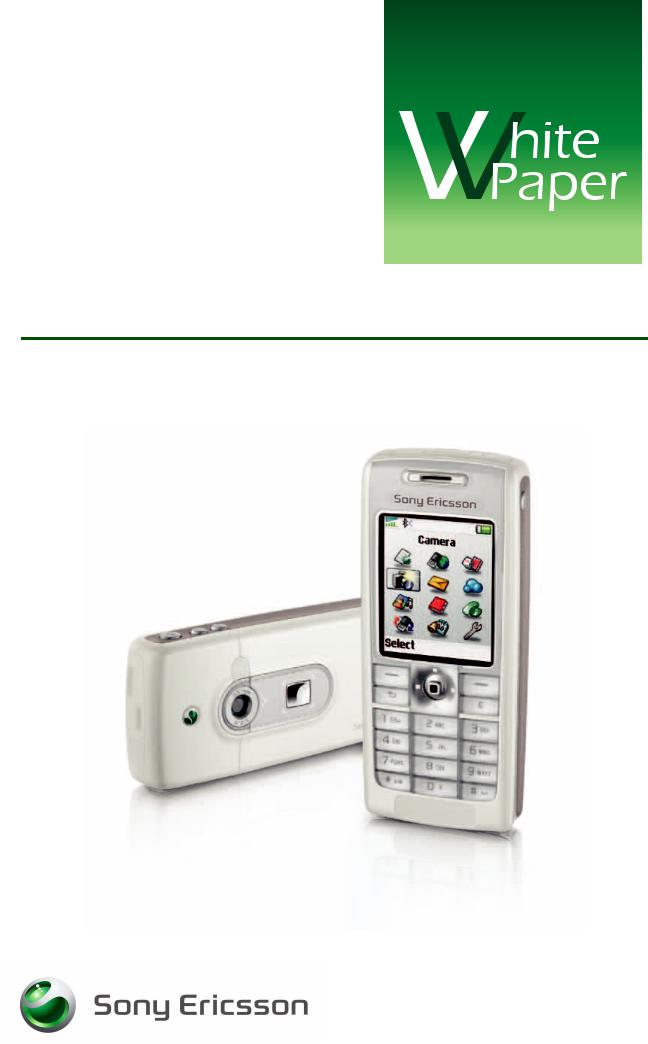
October 2003
T630/T628

White Paper T630/T628
Preface
Purpose of this document
The Sony Ericsson T630/T628 White Paper is designed to give the reader a deeper technical understanding of how the phones are designed, and of how they interact with other media. This document will make it easier to integrate the T630/ T628 with the IT and communications solutions of a company or organization.
People who can benefit from this document include:
•IT Professionals
•Software developers
•Support engineers
•Business decision-makers
More information, useful for product, service and application developers, is published on SonyEricsson Developer World, which contains up-to-date information about tecnologies, products and tools.
• Corporate buyers
This White Paper is published by:
Sony Ericsson Mobile Communications AB, SE221 88 Lund, Sweden
Phone:+46 46 19 40 00
Fax: +46 46 19 41 00 www.SonyEricsson.com/
© Sony Ericsson Mobile Communications AB, 2003. All rights reserved. You are hereby granted a license to download and/or print a copy of this document.
Any rights not expressly granted herein are reserved.
First edition (October 2003)
Publication number EN/LZT 108 6815
This document is published by Sony Ericsson Mobile Communications AB, without any warranty*. Improvements and changes to this text necessitated by typographical errors, inaccuracies of current information or improvements to programs and/or equipment, may be made by Sony Ericsson Mobile Communications AB at any time and without notice. Such changes will, however, be incorporated into new editions of this document are to be regarded as temporary reference copies only.
*All implied warranties, including without limitation the implied warranties of merchantability or fitness for a particular purpose, are excluded. In no event shall Sony Ericsson or its licensors be liable for incidental or consequential damages of any nature, including but not limited to lost profits or commercial lost, arising out of the use of the information in this document.
2 |
October 2003 |
White Paper T630/T628
Contents
Purpose of this document ..................................................................................... |
2 |
Key functions and features ....................................................................................... |
6 |
My friends .............................................................................................................. |
6 |
Sony Top 10’ ......................................................................................................... |
7 |
QuickShare TM ...................................................................................................... |
8 |
Built-in camera ...................................................................................................... |
8 |
Display ................................................................................................................... |
9 |
New and innovative user interface ........................................................................ |
9 |
Pictures ................................................................................................................ |
11 |
Multimedia in T630/T628 ..................................................................................... |
11 |
MMS (Multimedia Messaging Service) ................................................................ |
12 |
MMS objects ....................................................................................................... |
13 |
Benefits ................................................................................................................ |
14 |
EMS (Enhanced Messaging Service) ................................................................... |
15 |
Messaging using EMS ......................................................................................... |
16 |
Java ..................................................................................................................... |
18 |
Games ................................................................................................................. |
19 |
MIDI - Musical Instrument Digital Interface ......................................................... |
21 |
A fun, personalization, music application – Music DJ. ........................................ |
22 |
Polyphonic ring signals ........................................................................................ |
22 |
Bluetooth™ wireless technology ......................................................................... |
23 |
Using Bluetooth wireless technology in the T630/T628 ...................................... |
24 |
Synchronize calendar and phone book ............................................................... |
24 |
SyncML, an open standard for remote synchronization in the T630/T628 ......... |
24 |
Local synchronization .......................................................................................... |
27 |
WAP services ....................................................................................................... |
28 |
Bearer type characteristics .................................................................................. |
30 |
Gateway characteristics ...................................................................................... |
30 |
Security using the WAP ....................................................................................... |
31 |
Configuration of WAP settings ............................................................................ |
31 |
Push services ....................................................................................................... |
32 |
cHTML support .................................................................................................... |
32 |
Mobile Internet ..................................................................................................... |
33 |
Data connections ................................................................................................. |
33 |
Mobile positioning ............................................................................................... |
33 |
General Packet Radio Services ........................................................................... |
33 |
Using GPRS in the T630/T628 ............................................................................. |
34 |
Modem and AT commands ................................................................................. |
35 |
GSM data communication ................................................................................... |
35 |
AT commands support ........................................................................................ |
36 |
Online Developer Resources ............................................................................... |
36 |
Sony Ericsson Developer Support ....................................................................... |
37 |
Infrared transceiver .............................................................................................. |
37 |
Connection via infrared ........................................................................................ |
37 |
Chinese versions ................................................................................................. |
38 |
Network-dependent features ............................................................................... |
44 |
SIM application toolkit ......................................................................................... |
45 |
SIM AT services supported by the T630/T628 .................................................... |
46 |
User interaction with SIM AT ............................................................................... |
49 |
3 |
October 2003 |
White Paper T630/T628
Security and M-commerce technical data .......................................................... |
50 |
Terminology and abbreviations ........................................................................... |
50 |
Related information ............................................................................................. |
53 |
Technical specifications .......................................................................................... |
54 |
General technical data ......................................................................................... |
55 |
Exterior description .............................................................................................. |
55 |
Ambient temperatures ......................................................................................... |
56 |
Supported Man-Machine Interface (MMI) languages .......................................... |
56 |
Current consumption, talk and standby times .................................................... |
57 |
Speech coding ..................................................................................................... |
57 |
Cell broadcast service ......................................................................................... |
57 |
Short message service ........................................................................................ |
59 |
Enhanced message service ................................................................................. |
61 |
Multimedia message service ............................................................................... |
63 |
Bluetooth technical data ...................................................................................... |
65 |
Performance and technical characteristics ......................................................... |
65 |
Tone and percussion maps in the T630/T628 ..................................................... |
66 |
Percussion map ................................................................................................... |
69 |
WAP browser technical data ............................................................................... |
70 |
WAP Operator technical data .............................................................................. |
72 |
GPRS technical data ........................................................................................... |
76 |
Built-in GSM data modem technical data ........................................................... |
79 |
E-mail client technical data ................................................................................. |
79 |
USSD technical data ........................................................................................... |
81 |
Image format technical data ................................................................................ |
81 |
Images – downloading to phone ......................................................................... |
81 |
SyncML technical data ........................................................................................ |
83 |
Infrared transceiver technical data ...................................................................... |
83 |
4 |
October 2003 |
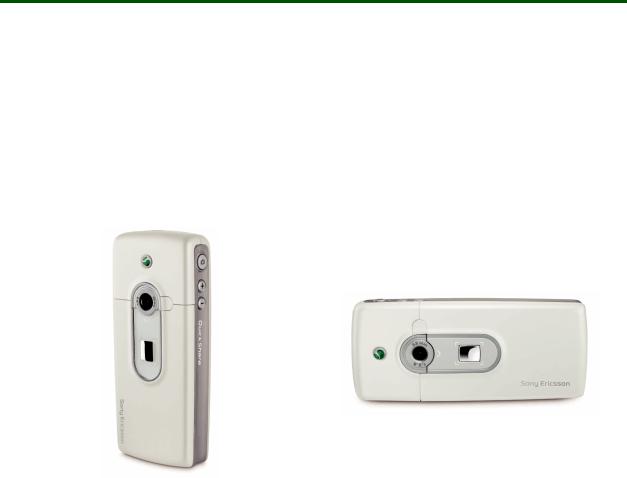
White Paper T630/T628
T630/T628 Product overview
T630/T628 is an innovative and easy to use highend mobile phone. It offers complete imaging and messaging capabilities that allow both family and friends to capture, share and preserve those special moments.
Designed with the professional user in mind, T630/ T628’s powerful efficiency makes it an ideal tool in the professional work place.
Featuring a large TFT colour display with 65,536 colours, it offers the viewer sharp, detailed images in rich, natural colours. The built-in camera makes taking a picture quick and easy and automatically shows the subject in the display. Pictures can then be used as wallpapers, in multimedia messages and in the phone book.
5 |
October 2003 |

White Paper T630/T628
Key functions and features
My friends
Sony Ericsson’s new application - My friendsena- bles an enhanced messaging facility that enables you to quickly access a list of contacts and quickly choose the mode of communication you wish to reach them by, such as SMS, MMS, e-mail, or chat.
The existing messaging facility in mobile phones can be improved to give users quicker access to their list of contacts and enable a service that is more user friendly and provides more options to the user.
The utility of My friends is also enhanced by the addition of a service that will keep track of the online status and availability of your chat partners or contacts; and notify you of changes to their status or availability.
The My friends application merges the Phonebook and messaging functionalities that we commonly find in phones. At a click you can access your list of My friends, and with another click you can choose how you want to communicate with them - via SMS, EMS, MMS, or other modes.
The application also enables you to view the ‘presence’, or availability of the contacts in My friends. You can easily and quickly find out whether they are on a call, in a meeting, or free to speak to you. You can then choose how you wish to contact them.
My friends contains all the information you need about your contacts.
You can have:
•a select list of up to 20 people
•their contact information such as phone number, E-mail, chat and mail addresses
•call information - calls to and from them
•presence information - their availability, online status (on or off), and any text or image they choose to send you regarding their availability
•message information - with regard to MMS, E- mail, chat, SMS/EMS, sent or received
You can present similar information about your own availability and status.
You have access to chatrooms, and can form wireless communities of business associates or contacts.
The Main View
You can access the My friends menu by clicking the desktop icon.
The icon in the status bar indicates the online status of the chosen friend in the list, and indicates new, unread messages if any.
The most likely action (which is context dependent) is available on the left softkey.
Additional actions become available to you when you press the More key.
Adding contacts to My friends
You can add a contact from the Phonebook to the list of My friends; and you can control the position of the friend in the list. This enables you to have your list of immediate business or social contacts at hand, so you can establish easy communication with them almost instantly.
6 |
October 2003 |

Managing My friends
Your list of immediate contacts may change to suit business demands. You may need to interact with new sets of persons depending on your current project or work at hand. Or you may simply want to alter your list of personal My friends whom you want to keep in constant touch with.
You can manage the My friends list to quickly alter the list of My friends that you want displayed. You can sort the names, edit nicknames, block or delete friend, or link a friend to Phonebook.
White Paper T630/T628
Viewing the status of contacts in My friends
You can view the status of contacts in My friends before you decide to contact. Click More on the right side bottom of the My friends list to access the More menu; and click View status.
You can view your contact’s status and decide how you want to communicate with him or her. You may want to call or send an SMS, MMS, or e-mail, or join your friend in a chatroom.
Access to the chatroom
The My friends application supports chatroom invitations. You can bookmark associates you would like to chat with. The application can establish connectivity between different service offerings that enable chat between terminals.
Sony Top 10’
Sony Top 10 is a unique direct-link music download application which is easy to use and promises you best-selling music for mobile download.
By pressing an icon on the phone desktop, you can go straight to a live list of Top Music Hits. Choose a song, listen to it, and if you like what you hear you can add it to My Sounds.
7 |
October 2003 |

The Sony Music Top 10 service can be owned by a network operator and/or hosted by Sony Ericsson and the premium content maintained and managed by Sony Music. The music on offer can easily be suited to a specific region or target group.
The music format is Midi (Polyphonic 24 voices or more).
Implementation costs for network operators are minimal and server communication is based on existing, well-established systems and services.
White Paper T630/T628
Operator benefits
Sony Music Top 10 creates quality and quantity revenue for network operators. The process involves:
•Accessing online music
•Downloading list
•Choosing a song
•Buying a song
* Available in customized phones only.
QuickShare TM
The Sony Ericsson QuickShareTM is the smartest, fastest and easiest way to share images. By combining several imaging features and capabilities in
the T630/T628, QuickShareTM lets you take a picture with two rapid clicks and then in four further steps send it anywhere in the world.
It is also possible to exchange pictures directly over Bluetooth connections and even drag and drop pictures to and from the T630/T628 and a PC.
Built-in camera
The built-in camera is capable of taking still pictures up to common image format (CIF) resolution (288 x 352 pixels) and 24 bit colour depth. In addition, it is possible to let the phone automatically resize the image to VGA resolution (480x640 pixels). The lens is recessed into the back cover of the T630/T628. The viewfinder will fill up the whole screen, irrespective of the resolution at which the picture is taken. A dedicated hardware button provides fast access to the camera application.
Images are stored in the phone’s filing system and are therefore available for other applications to use. The number of images that can be stored depends on the available file space, which is shared with other applications. The viewfinder will give an estimation of the number of images remaining, assuming that all of the free storage is available for the camera application and using the current settings for size and quality. Approximate JPEG file sizes are 20 kbytes for CIF.
Saved images may be viewed in the image viewer application, and are available for use by other applications in T630/T628 such as MMS and e- mail.
8 |
October 2003 |
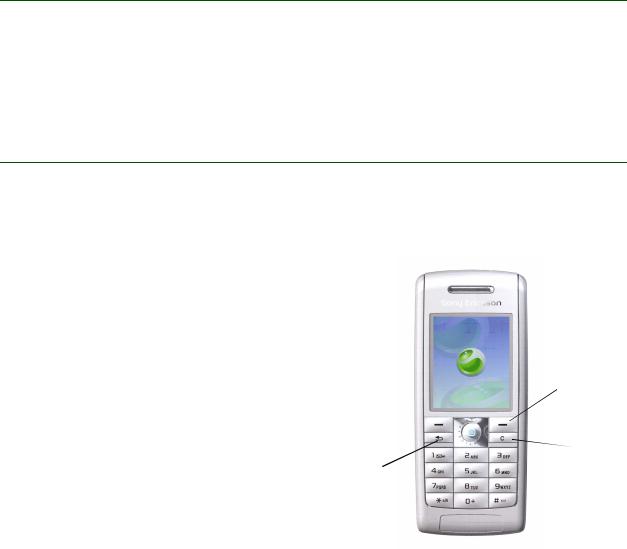
White Paper T630/T628
Display
The T630/T628 lets the user enjoy the ultimate viewing experience afforded by the 65,536 full colour LCD. The LCD has 128x160 pixels and is a 1.8 ” TFT screen. The display has a 16 bits pixel mem-
ory depth. Camera pictures, picture messages and gaming are all enhanced by the crisp, sharp colours afforded by the TFT. The screen also offers the user maximum information with the least scrolling.
New and innovative user interface
The T630/T628 has a new, innovative user interface which enables the user to manage the phone in an easy and efficient way. Combined with attractive graphics in a wide variety of styles, the new user interface gives the user a new and stimulating experience.
The development of the new user interface is founded on usability tests performed on a wide range of mobile phones - Sony Ericsson phones as well as competitors’. The result is a new interface that is easier and quicker to use than the vast majority in products on the market.
The keys to efficiency
The lay out of the keys is one of the many new and improved elements in the T630/T628, helping the user to find functions and features in the phone quickly and easily. Conveniently and ergonomically grouped together on the front, the two soft keys, a navigation key, the back key and the “C” key enable the user to navigate, select and perform actions.
Actions and options
The left and right soft keys perform the actions shown immediately above these keys in the display. The most frequently used actions are always available on the left soft key. Other actions are accessible on the right soft key, directly on the key or via the More list. Since most of the common actions are carried out by the left soft key, the back key is conveniently placed immediately under it.
|
|
|
On/Off key |
|||||||
Camera |
|
|
|
|
|
|
Internet |
|||
|
|
|
|
|
|
|||||
|
||||||||||
key |
|
|
|
|
|
|
|
key |
||
|
|
|
|
|
|
|||||
Volume |
|
|
|
|
|
|
|
|
|
|
|
|
|
|
|
|
|
|
|
||
keys |
|
|
|
|
|
|
|
|
||
Left soft |
|
|
|
|
|
Right soft |
||||
key |
|
|
|
|
|
key |
||||
Back key |
|
|
|
|
|
|
|
C key |
||
|
|
|
|
|
|
|
|
|||
|
|
|
|
|
|
|
|
|
|
Number |
|
|
|
|
|
|
|
|
|
|
|
|
|
|
|
|
|
|
|
|
keys |
|
|
|
|
|
|
|
|
|
|
||
Back and delete
The Back key enables the user to go back one step at the time. It makes it easy to find the way back, but more importantly gives the possibility to recover from mistakes. To press and hold the Back key is an instant return to stand by.
The “C” key is used to delete items and to turn off sounds:
•Press and hold in Stand by - activate silent mode
•Press and hold during ongoing call - mute
•Normal press during incoming call - mute ring
9 |
October 2003 |
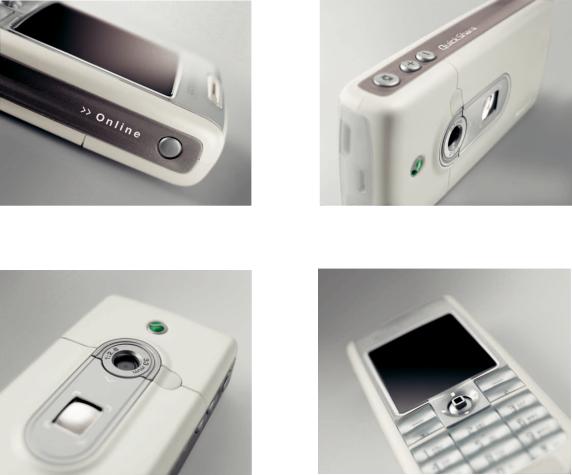
More Features
The key features in the phone are easily accessible, and the main menu is reached by a press with the navigation key in stand by. It is also accessible during an ongoing call, which allows for multitasking - an air time generator. The main menu gives an overview of all functions and features in the phone.
Actions in the T630/T628 are always carried out in the most efficient way, and there is always a visible status bar at the top of the display. The status bar extends the usage of non voice features by displaying icons and indicators of ongoing actions.
White Paper T630/T628
The already popular Themes in Sony Ericsson mobile phones have been further developed and improved in the T630/T628, enabling the user to personalize the phone with pictures, colours, wallpapers, etc. The Themes and all their features are displayed in the large 65k colour screen, which gives a unique user experience.
10 |
October 2003 |

White Paper T630/T628
Technologies in detail
Pictures
Pictures is the T630/T628’s image viewer. It enables you to view and organise your photographs, including pictures taken by the built-in camera plus images loaded from elsewhere, such as received via e-Mail. Pictures supports image types JPEG, GIF, Animated GIFs and WBMP.
Pictures can be viewed in thumbnail and full screen mode. Thumbnail images may be ordered by name, date, size or type. In full screen mode the user can browse through the images and rename or delete them. It is also possible to send them as e-mail, MMS messages or via Bluetooth and infrared. Sim-
ply select a picture, add a message and send just like an SMS message or build a slide show with several images and your favourite sound clips.
Pictures of loved ones can be saved in Contacts. When a contact calls (or the user calls that contact), the picture is displayed with the details of the call. This is known as Picture Phone Book.
Pictures may be loaded up to the Internet. Sony Ericsson Mobile Internet has an on-line album enabling you to share pictures and video clips: wap.sonyericsson.com
Multimedia in T630/T628
Graphics
Graphics (tables, charts, diagrams and layouts) have a major impact on the way we work. The T630/T628 supports JPEG (max 640x480), GIF (max 640x480), PNG (max 640x480), BMP ( max 640x480), WBMP (max 320x320) and animated
GIFs. With MMS, the user can personalize the appearance of the display – for example the background colours and the background picture.
11 |
October 2003 |
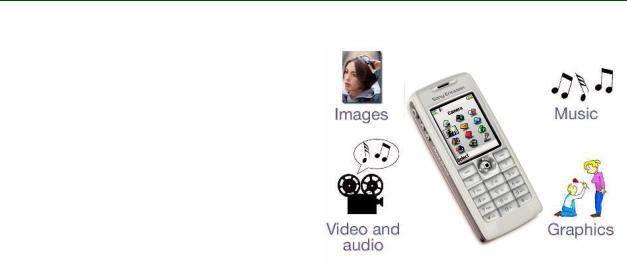
White Paper T630/T628
Audio
With the sound recorder function in the T630/T628, it is easy to make a voice recording, for example a personal rendition of “Happy Birthday”. The audio function in the T630/T628 also allows downloading of sounds and melodies.
Themes
With themes, the user can change the appearance of the display, for example the background colours and the background picture. The phone comes with a number of pre-defined pictures, and it is possible to download additional themes. The maximum number of themes is limited only by the amount of memory.
With inbox, outbox, save draft and reply options, you have all the functions you need for effective e- mail communication in a powerful mobile phone. Constantly connected to a POP3, SMTP or IMAP4 e-mail server anywhere on the Internet, your T630/ T628 stores messages dynamically, depending on available memory, and updates your inbox automatically and over the air. Check your e-mail anywhere. Reply to e-mail on the move. Friends, family and business contacts know that when they send you e-mail, you can receive, read and act on it immediately. You can include pictures in outgoing e-mails and receive attachments. Hyperlinks in e- mails are supported.
MMS (Multimedia Messaging Service)
One of the key features in the T630/T628 is the Multimedia Messaging Service (MMS), this is expected to become the preferred messaging method of mobile terminal users, since there are virtually no limits to the content of an MMS transmission. An MMS message (also known as a Picture Message) from the T630/T628 can contain text, pictures, graphics, animations, images, audio clips and ring melodies. For third-party developers’ information, please visit the Sony Ericsson Developer World.
Defined and specified by 3GPP as a standard for third generation implementation, MMS completes the potential of messaging. Sending digital postcards and PowerPoint-style presentations is expected to be among the most popular user applications of MMS. Eagerly awaited by young users in particular, MMS is projected to fuel the growth of related market segments by as much as forty percent.
Figure 1. An MMS message can contain images, music, audio and graphics.
Using the Wireless Application Protocol (WAP) as bearer technology and powered by the high-speed transmission technologies EDGE, GPRS and UMTS (W-CDMA), Multimedia Messaging allows users to send and receive messages that look like Power- Point-style presentations. The messages may include any combination of text, graphics, photographic images, speech and music clips. MMS messaging will serve as the default mode of messaging on all terminals, making total content exchange second nature. From utility to sheer fun, it offers benefits at every level and to every kind of user.
12 |
October 2003 |

White Paper T630/T628
MMS objects
Although MMS is a direct descendant of SMS, the difference in content is dramatic. The size of an average SMS message is about 140 bytes, while the maximum size of an MMS message is limited only by the memory. That is why the key word to describe Picture Message content is rich. Complete with words, sounds and images, MMS content is endowed with the user’s ideas, feelings and personality. An MMS message can contain one or more of the following:
Mobile picture transmission also offers inestimable utility in business applications, from sending onsite pictures of a construction project to capturing and storing an interesting design concept for later review. Editing a picture by adding text allows users to create their own electronic postcards, an application that is expected to substantially cut into the traditional postcard-sending market.
Themes (downloaded or pre-defined) can be exchanged via MMS.
Text
As with SMS and EMS, an MMS message can consist of normal text. The text can consist of up to 1000 characters. The main difference between an EMS and MMS message is that in an MMS message, text can be accompanied not only by simple pixel images or melodies but by photographic images, graphics, audio clips and in the future, video sequences.
Templates
The T630/T628 comes with a number of MMS predefined templates, for example templates for birthday cards, meeting requests etc.
Audio
MMS provides the ability to send and receive full sound (iMelody and AMR) messages. Not only can users share a favourite song or ring signal with a friend, they can also use the mobile phone to record sound and send it along with a message. Because sound includes speech as well as music, this extra dimension of an MMS message makes for enhanced immediacy of expression and communication. Rather than sending a downloaded birthday jingle in EMS, for example, a user can send a clip of his or her own personal rendition of “Happy Birthday”.
SMIL presentations
SMIL stands for Synchronized Multimedia Integration Language and is pronounced “smile”. SMIL in the T630/T628 allows the user to the create and transmit PowerPoint-style presentations on the mobile device. SMIL is an advanced XML-based protocol, and Sony Ericsson MMS supports a subset of this protocol. Using a simple media editor, users can incorporate audio and animated GIFs along with still images, animations and text to assemble full multimedia presentations.
The idea of SMIL is to allow the user to customize the page timing in PowerPoint-style presentations. The user can decide in which order the image and text will be displayed, as well as for how long the images and text lines are to be shown in the display
PIM communication with MMS
With MMS in the T630/T628, it is easy to send and receive business cards, calendar entries and notes.
Business card (vCard)
With MMS in the T630/T628, the user can send a business card.
Pictures and themes
By using the built-in digital camera in the T630/ T628 users can take a snapshot and immediately send it to a recipient. The ability to send pictures is one of the most exciting attributes of MMS, as it allows users to share meaningful moments with My friends, family and colleagues.
Calendar entry (vCal)
With the vCal function the user can enclose a vCal entry when sending a meeting request via MMS.
Notes
The T630/T628 supports vNote. Notes can be sent via MMS.
13 |
October 2003 |
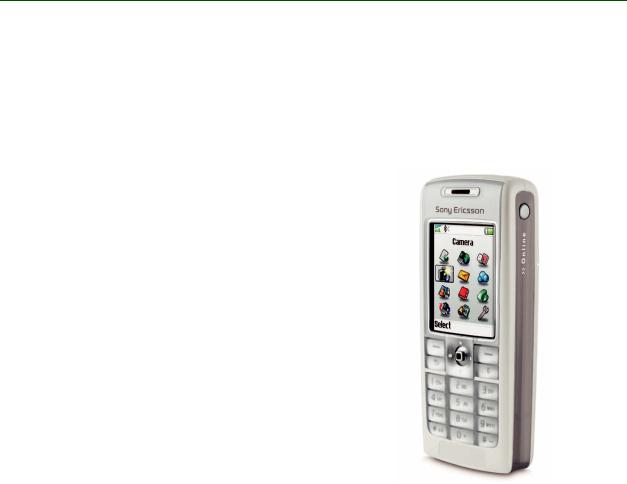
White Paper T630/T628
Benefits
Essentially enabling the mobile terminal to serve as image processor and conveyor, Multimedia Messaging accommodates the exchange of important visual information as readily as it facilitates fun. Business and leisure usage of MMS will be dynamically merged, resulting in enhanced personal efficiency for users and increased network activity for operators. In short, MMS affords total usage for total communication
Because MMS uses WAP as its bearer technology and is being standardized by 3GPP, it has wide industry support and offers full interoperability, which is a major benefit to service providers and end users. Ease-of-use resulting from both the gradual steps of the messaging evolution and the continuity of user experience gained from interoperability is assured.
The MMS server, through which MMS messages are sent, supports flexible addressing (to both normal phone numbers (MSISDN) and e-mail accounts), which makes user interface more friendly and allows greater control for operators. The MMS server, moreover, is responsible for the instant delivery feature of MMS.
MMS technical features
The MMS standard, just like SMS, offers store-and- forward transmission (instant delivery) of messages, rather than a mailbox-type model. MMS is a person-to-person communications solution, meaning that the user gets the message directly into the mobile phone. He or she doesn’t have to call the server to get the message downloaded to the mobile phone. Unlike SMS, the MMS standard uses WAP as its bearer protocol. MMS will take advantage of the high speed data transport technologies EDGE and GPRS and support a variety of image, video and audio formats to facilitate a complete communication experience.
Architecture
The MMS Centre (MMS-C) is comprised of the MMS Server, the MMS Proxy-Relay and the MMS Store. The MMS Centre is the central element of the MMS network architecture, providing storage and operational support, enabling instant delivery of multimedia messages from terminal-to-terminal and terminal-to-e-mail, and supporting flexible
addressing. The centre’s MMS Proxy-Relay interacts with the application being run on the MMSenabled terminal to provide various messaging services. WAP is used as bearer of an MMS message between the MMS-C and the MMS client (application). The WAP Gateway is used for delivery and retrieval of messages.
14 |
October 2003 |

Message conversion
The MMS-C is able to perform limited message conversion - for example, from MMS to SMS - so that processing and air time is not wasted in sending messages to mobile terminals that do not have adequate capability to receive them. It also handles service aspects such as store and forward, guaranteed delivery, subscriber preferences, operator constraints, and billing information. The MMS-C also vouches for high quality messaging, e.g. by format conversion. This means that the MMS-C
White Paper T630/T628
recognizes which formats are supported in the mobile phone, and adapts the MMS messages to these formats.
OTA configuration
Users can easily get MMS into their phone. MMS supports OTA, meaning that the user does not have to configure the settings manually. The configuration is done by the operator.
EMS (Enhanced Messaging Service)
EMS uses existing SMS infrastructure and industry standards, keeping investments to a minimum for operators and providing a familiar user interface and compatibility with existing phones.
15 |
October 2003 |

White Paper T630/T628
Sounds and melodies
EMS gives the user the ability to send and receive melodies. These can be pre-defined sounds, downloaded from the Internet, received in SMS messages or composed by the user on the phone keypad or a PC.
Several sounds and melodies can be inserted in one message, and they can be combined with pictures.
Pictures and animations
Phones supporting EMS include a set of predefined animations. New pictures and animations can be downloaded from the Internet or received in SMS messages.
Pictures can be created and edited in the phone using a built-in Picture Editor. Several pictures can be inserted in one message, and they can be combined with sounds and melodies.
Messaging using EMS
Concatenated messages
A part of the EMS standard is the support for concatenated messages, which means that the phone is able to automatically combine several messages both when creating and receiving EMS. This is useful to be able to build and display messages with rich content since the amount of information in each SMS is limited by the SMS standards.
Compatible with SMS standards
Users will find EMS as easy to use as SMS. At the moment 15 billion SMS messages, are sent every month worldwide. Roughly 80% of this traffic is user-to-user i.e. mobile phone users sending short messages to each other using the keypad of the phone to enter text. The remaining 20% is shared by downloads and notifications of different kinds.
Huge business potential
Network operators can now enhance their services and attract more customers by offering pictures, animations, ring signals and melodies for download at their portals. Operators can charge more per EMS message since it contains more data. Thereby EMS adds more value to the operators and to the end users.
now stable and complete as part of the 3rd Generation Partnership Project (3GPP) technical specification.
EMS dynamics
An EMS message can be sent to a mobile phone that does not support EMS, or only supports part of EMS. All the EMS elements i.e. text formatting, pictures, animations and sounds are located in the message header. The EMS contents will be ignored by a receiving phone that does not support the standard. Only the text message will be displayed to the receiver. This is true consumer-friendly standardization.
Examples of EMS contents and applications
A wide range of contents, applications and services may be developed. Below is a list of examples and areas where messaging can be enhanced with EMS.
User-to-user message
Messages usually originating from the keypad of a mobile phone can include pictures, animations, melodies, formatted text with EMS.
Standards
The Enhanced Messaging Service (EMS) was first submitted to the standards committees by Ericsson. Ericsson presented the outline structure of EMS to the relevant ETSI/ 3GPP committees. The major mobile phone manufacturers and most operators are actively contributing to the 3GPP standards. Hence the EMS standard has evolved and is
Voice and e-mail notifications
Notifying mobile phone users that they have new voice or fax mail messages waiting - including icons or melodies with EMS.
16 |
October 2003 |
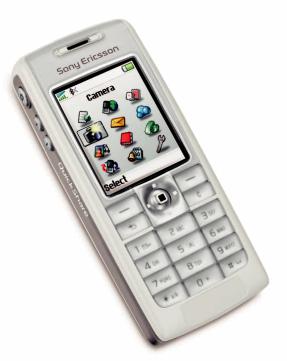
Unified messaging
The user typically receives a short message notifying them that they have a new message in their unified messaging box, with icons or formatted text further enhancing the message.
White Paper T630/T628
or courier package delivery, using EMS in a retail environment for credit card authorization, remote monitoring of machines for service and maintenance purposes.
Internet e-mail alerts
An Internet e-mail alert is provided in the form of a short message that typically details the sender of the e-mail, the subject field and first few words of the e-mail message, and in this case formatted text is excellent to identify message elements.
Ring signals
Downloading ring signals from the Internet
News & commercials
World news illustrated, sports scores and news headlines, finance and stock market news with diagrams and tickers, commercial product promotions, weather reports with maps, tunes from TV commercials as ring signals.
Info & entertainment
Ring signals, e-greetings, football club logo, joke- of-the-day illustrated by pictures or sound, horoscopes, movie related animation or theme song, TV show promotions, music artist promotions, lottery results, food and drinks pictures and recipes, mood-related pictures.
Corporate
Flight schedules, pre-installed corporate logos, map snippets and travel info, company branded icons and ring signals, corporate e-mail notifications, affinity programmes where companies notify customers of product updates etc., banks notifying customers about new services and interest rates, call centres providing answers to questions about a product, vehicle positioning combining EMS with Global Positioning System (GPS) position information, job dispatch with delivery addresses for sales
Using WAP, WAP and SMS for download
Already today services exist on the Internet where users can create melodies, and view icons and pictures, subscribe to entertainment and informations services. These may develop further in the future to support access via PC over the Internet, from the phone using WAP and even with an SMS request interface.
17 |
October 2003 |
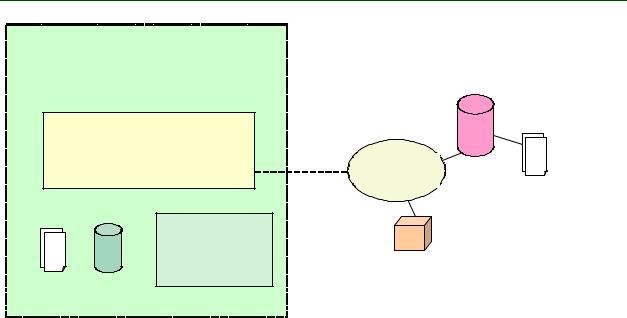
White Paper T630/T628
Java
J2ME
CLDC
Sandbox
|
MIDP Application |
|
|
running on |
|
|
MIDP/CLDC/kVM |
Internet |
|
HTTP/ |
Services and pages |
|
Datagram |
with response in |
|
User Interface |
HTML format |
|
|
|
JAR file |
Persistent |
Other networked |
devices (datagram |
||
resource |
Storage |
communication) |
The T630/T628 supports J2ME CLDC/MIDP. It is ready to run applications written for handheld computers and mobile phones.
Applications are easily downloaded directly to the T630/T628 using the browser, or may be installed from a connected PC. Applications such as the currency converter can obtain the latest exchange rates from the Mobile Internet and then make up- to-date calculations. It is also possible to access and download data from a company server.
T630/T628 supports JSR-135 allowing control of the synthesizer for MIDI, I-melody and Tone sequence playback.
Optional download features
The browser can download JAR/JAD files from WAP and HTML pages provided that the server supports the actual file types. T630/T628 can also download JAD/JAR files from ordinary WAP servers provided that they support the mime type for each of the file types.
Supported protocols
The T630/T628 supports “Sun OTA recommended practice for J2ME CLDC/MIDP” and ordinary MIDP 1.0 applications without extension API’s.
Sandbox security concept
J2ME/CLDC uses a sandbox security concept which includes a number of system components working together to ensure that untrusted applications cannot gain access to system resource.
Selection keys
When executing a MIDP application a lower portion of the screen is reserved for displaying selection keys associated with the application. The appearance of this soft key area at runtime depends on which base class the displayed application is derived from.The left soft key is for the first command in the command list and the right soft key is for the “More” list and “Help”.
18 |
October 2003 |

White Paper T630/T628
General information
Implementation |
|
|
|
CLDC |
1.0 |
|
|
MIDP |
1.0 |
|
|
JSR |
135 |
|
|
Support |
Over the Air Recom- |
|
mended Practice |
|
|
Permissions |
Net Access |
|
|
|
|
Memory |
|
|
|
Heap size (RAM) |
256 KB |
|
|
Max no.of applications |
50 |
|
|
Size of applications |
Approximately 60 KB |
|
|
File system size |
Up to 2 MB |
|
|
Number of simultaneous |
One |
executing applications |
|
|
|
Note: For more information, visit the Sony Ericsson
Developer World.
Games
T630/T628 has four games pre-loaded and more can be easily downloaded. The games download is made possible by a true virtual machine. The Sony Ericsson portal for downloading of free games for the T630/T628 is accessible with only one key press in the games menu. The openness of the downloadable games solution is dedicated to provide an enhanced gaming experience.
Downloadable games can fully take advantage of the phone´s interfaces, such as TCP/IP, SMS/MMS, 32 voices polyphonic sounds, and vibrator. The virtual machine executes the downloading of games for the optimal game experience. The user can download an unlimited number of games as long as the file system allows it, i e until the phone memory is full.
The downloading concept includes certification of the games, which makes it possible to create a revenue chain and favourable business opportunities
for network operators and content providers. The virtual machine uses true sandbox technology for the highest level of security.
mophun ™
mophun™ is a software based gaming console for mobile terminals. It offers the user optimized graphics and interaction access to ensure the best possible gaming experience.
mophun™ gamelets will drive traffic and increase revenue for operators.
mophun RTE
The mophun™ runtime environment consists of a virtual machine that requires less than 40kb of memory. Its small size means that it can fit inside the instruction cache of the host CPU. It has a
19 |
October 2003 |
White Paper T630/T628
native code interface that requires as little as 10 machine instructions (depending on the host system) overhead for calls to native functions.
Emulation profiles for the target mophun™ enabled mobile terminal are included in the SDK. It also ships with a full set of binary utilities for manipulation and handling of code, data and resources.
Gaming API
The gaming API provides all the functionality a game requires. It provides platform independent video access, input, sound and communication. It also features a query interface that lets you adapt a game to the capabilities of the device. The API consists of 100% native code that ensures the best possible performance.
Because different platforms have varying capabilities, this gaming API has been created with differentiators such as a built in sprite engine, map engine, different color depth tiles and transparency support etc. With this gaming API it is possible to isolate code and data into modules that can be loaded according to the capabilities of various platforms. It is possible to have both grayscale and color graphics resources but only load the specific resources that are compatible with the surrounding system. Games that do not provide multiple resources are not a problem because the mophun™ system automatically handles the conversions. Indeed, future extensions even include a 3D API.
Certification and deployment
Each game must be certified by Synergenix Interactive AB before it can be run on a mobile phone. This ensures there is no offensive content, that the game is of sufficient quality and that the gameplay and functionality conform to settled standards.
A game file can be downloaded via WAP or cable from an operator’s page or from any publisher’s WAP page. If the download is supposed to be in one session, the file size should be less that 60 000 bytes.
Game file sizes
Each game has its own directory in the file system. A game directory in the T630/T628 can contain up to 16 different files but together they may not exceed an aggregate of 480 000 bytes.The maximum size of files for downloading depends on the size of the WAP gateway. When provisioning mophun games that are larger than the WAP gateway limitation, the games may be split up in portions and reassembled on the mobile terminal.
Secure gamelets
mophun™ gamelets are executed in a secure sandbox environment that eliminates any possibility of illegal actions. A secure layer exists between the mophun™ application and the “real” system interfaces. Security is further enhanced as result of the gamelets having to be digitally signed before execution on the mobile terminal is possible. Gamelets are signed in the publishing process after being screened for malicious content.
Software development kit
The mophun™ SDK is built with GNU tools using open standards. It is non-proprietary and is offered to developers completely free of charge. Games are written in C/C++ or assembler and the kit was built by game developers. A general PC can be used to both write and test the software without any need to access the real device. Source level debugging is available for both the Linux and Windows versions of the SDK.
Functions
Send/receive via TCP/IP link |
Yes |
|
|
Send/receive via SMS |
Yes |
|
|
Send/receive via Bluetooth |
Yes |
|
|
Send/receive via infrared |
Yes |
|
|
Vibrator on/off |
Yes |
|
|
Backlight on/off |
Yes |
|
|
Colour support |
Yes |
|
|
Certification control of games |
Yes |
|
|
True sandbox technology |
Yes |
|
|
True file support |
Yes |
|
|
Sprite detection collision |
Yes |
|
|
Built-in Unicode including Chinese |
Yes |
|
|
20 |
October 2003 |

Getting started
In order to receive the mophun™ SDK developers must go to http:// www.mophun.com and download the free software. Developers will also benefit from the full support package that is available at Sony Ericsson Developer World. Everything needed to begin developing games for Sony Ericsson mobile phones is available at these sites.
Game controls
Use the navigation key to move up, down, left or right and to select an item, or use the keys as follows:
Select the options that might appear in the display immediately above these keys.
|
|
|
|
|
|
|
|
|
|
|
|
|
|
|
|
|
|
|
|
Press once to |
|
|
Delete num- |
||||||
go back one |
|
|
bers, letters or |
||||||
level in the |
|
|
an item from a |
||||||
menus. Press |
|
|
list. |
||||||
and hold to |
|
|
|
|
|
||||
return to stand- |
|
|
|
|
|
||||
by. Exit the |
|
|
|
|
|
||||
game. |
|
|
|
|
|
||||
|
|
|
|
|
|
|
|
|
|
|
|
|
|
|
|
|
|||
|
|
|
|
|
|
|
|
|
|
left and up |
up |
right and up |
|||||||
White Paper T630/T628
|
|
|
|
|
|
|
|
|
|
|
|
|
|
|
|
|
|
left |
select or fire |
right |
||||||
|
|
|
|
|
|
|||
|
|
|
|
|
|
|
|
|
|
|
|
|
|
|
|
|
|
|
|
|
|
|
|
|
|
|
left and down |
down |
right and down |
||||||
|
|
|
|
|
|
|
|
|
Other useful key functions:
•Press START to start a new game.
•Press EXIT to finish a game.
•Press MORE to delete, view game info, or view memory status.
Note: The above text and control panel does not apply to Java games.
Gameboard EGB-10
The Sony Ericsson Gameboard EGB-10 can be purchased separately as an accessory. It lets you take the maximum fun and functionality of your phone’s gaming potential with you wherever you go. It offers:
•8-way game pad
•4 functional keys
•Ergonomic design
MIDI - Musical Instrument Digital Interface
The T630/T628 contains an advanced MIDI composer that allows the user to compose melodies and ring signals in polyphonic sound. A MIDI signal or file does not contain any music. It contains
21 |
October 2003 |
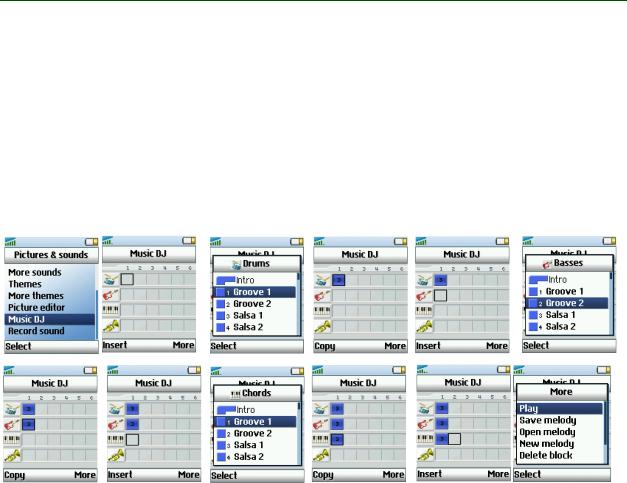
White Paper T630/T628
binary data (information) of how a melody is played and when this data reaches a synthesizer, the synthesizer will translate the binary data to music, when connected to an amplifier with speakers so that the sound becomes audible.
The development from the iMelody format to the MIDI format means a revolution to the sound quality. The MIDI files are small, and perfect for mobile
devices, which have limited storage capacity. MIDI is a specification for a communications protocol principally used to control electronic musical instruments. MIDI is today a well known standard used by musicians, composers and arrangers.
A fun, personalization, music application – Music DJ.
The Music DJ lets the user select pre-recorded musical loops to compose a melody in much the same way as modern artists create music through more advanced systems. Music DJ enables the user to create and edit a polyphonic ring signal using only “blocks” containing ready-mixed sequenced loops played by different instruments. The blocks are kept in banks or libraries. This application makes it possible for even semi-profession- als to customize their mobile phones and to test new melodies while on the move.
Composing
You can compose and edit melodies to use as ring signals. A melody consists of four tracks - Drums, Basses, Chords and Accents. A track contains a number of music blocks. The blocks consist of prearranged sounds with different characteristics. The blocks are grouped into Intro, Verse, Chorus, and Break, depending on where in the melody they fit in. You compose a melody by adding music blocks to the tracks.
22 |
October 2003 |

White Paper T630/T628
Polyphonic ring signals
Protocol
The T630/T628 has a hardware synthesizer chip, built into the mobile phone. The software controls the MIDI files, and makes sure they fit into the hardware chip. It is possible to modify the dynamics, and it is possible to make the sound escalate, start quietly and grow louder.
The T630/T628 Sony Ericsson mobile phone completely supports the MIDI 1.0 detailed specification. Please visit http://www.midi.org/ for more information.
The quality of the sound heard from the speakers depends on many different things, for example on the synthesizer, the amplifier, or the speakers. An important factor for sound quality is the number of voices. The human ear cannot separate each voice if the number of voices increases above about 16, then the voices merge together. But the nuances in the music increase, and the music is experienced as more sophisticated if the number of voices increases. Many modern sound modules in synthesizers used by musicians have 16, 24 or 32 note polyphony. The number of voices used in the T630/ T628 is 32, which gives excellent sound quality.
Excellent sound quality – 32voices
The human ear can hear sounds from approximately 20 Hz up to 20 KHz. In most GSM mobile phones, the speech sound range is from 300 Hz to 3400 Hz, which is good enough for speaking, but quite poor for music. The T630/T628 can handle up to 15000 Hz, equivalent to an FM stereo radio, which means excellent sound quality.
T630/T628 has a dedicated speaker to ensure the best possible sound quality. This speaker is situated on the back of the phone ensuring no discomfort is felt if a second call is received during an ongoing call. It also ensures louder ring signals and removes the need for escalating rings signals.
Wavetable synthesis
Sony Ericsson has chosen to implement the Wavetable synthesis, which consists of sampled real instruments, which gives a much higher quality than the FM-synthesis. Especially the treble is more distinguished.
Touch correct feature
The so called “Touch correct” feature makes dynamic compression possible. This equalizes the amplitude of the instruments included in the MIDI file, which greatly improves the sound quality, especially in melodies with big differences in amplitude.
Bluetooth™ wireless technology
The T630/T628 features built-in Bluetooth wireless technology. Its short-range radio link operates in the globally available 2.4 GHz radio frequency band, ensuring fast and secure communications up to a range of 10 metres.
Bluetooth wireless technology is designed to be fully functional even in noisy radio frequency environments. All data transfer is protected by advanced error-correction methods, ensuring a high level of data security. Bluetooth wireless technology facilitates instant connections, which are maintained even when the devices are not within line of sight. High-quality voice transmission is pro-
vided under adverse conditions, making it possible to use a headset connection to the T630/T628 at all times.
Ericsson was a founding partner of the Bluetooth Special Interest Group (SIG). Bluetooth wireless technology devices that are expected to be available in the near future, include:
•Headsets for wireless voice transmission and remote call control
•PCs, laptops, PDAs, palmpads for data transfer, synchronization etc.
23 |
October 2003 |

•PC cards for Bluetooth wireless technology in laptops and PDAs
•MP3 music player
•Other phones for exchanging business cards, ring signals, playing games etc.
•Digital still and motion video cameras
•Printers, hard disks and other storage devices
White Paper T630/T628
•Handheld scanners for text, barcodes and images
•Household appliances with built-in logic, as well as games and entertainment devices
•Access points in hotel lobbies and airports for connecting to computer networks and the Internet
•Car handsfree solutions
Using Bluetooth wireless technology in the T630/T628
Key benefits include:
•True wireless connection
•Cable replacement for connecting to headsets, computers, networks, printers and other devices.
•The T630/T628 identifies and maintains several devices in a pairing list.
•Radio link
•No line of sight required; the phone can remain in a briefcase or in a pocket, as long as no solid objects are in between (whereas infrared requires line of sight).
•Secure and fast
•Data connection with a Bluetooth PC/laptop turns the phone into a modem for connecting to the Internet and for data transfer (faster than infrared or cable).
•Synchronization
•Fast synchronization, even without line of sight, of calendar and phone book with PC/laptop and PDA, and quick exchange of business cards, calendar events and melodies with other phones and devices.
Synchronize calendar and phone book
In everyday life, access to an updated calendar and addresses of My friends and business colleagues is greatly appreciated. To be truly mobile, users must be able to carry their important information with them. Equipping mobile phones with Personal Information Manager (PIM) programs such as calendars, to-do lists and address books gives users access to their most important data anywhere and anytime. The information is kept updated by synchronizing with the information at the office or at home.
Hierarchical phone book with contacts
The T630/T628 features a hierarchical phone book. For every contact, details such as name, home, work and mobile numbers, pager number, e-mail address and other information can be stored. The hierarchical phone book in the T630/T628 is compatible with most groupware and agenda programs, such as Microsoft Outlook, enabling smooth local synchronization of contact information between the phone and a PC, via cable, Bluetooth wireless technology or IR. For remote synchronization of Contacts and Calendar over WAP, the T630/T628 supports SyncML.
24 |
October 2003 |
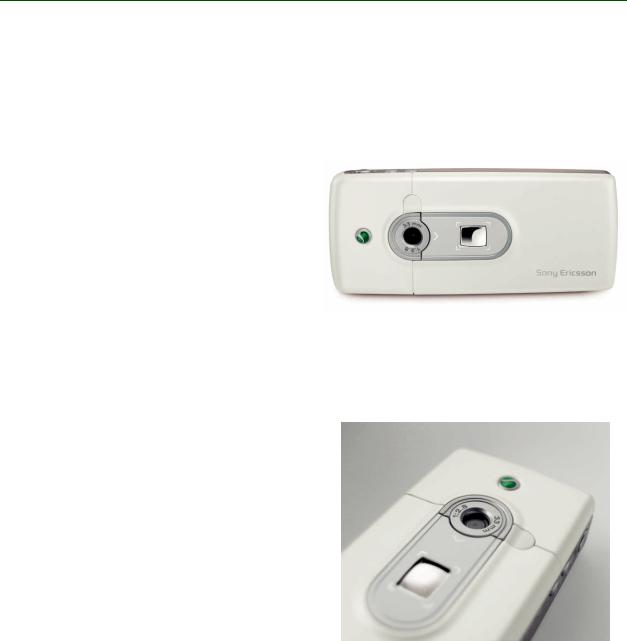
White Paper T630/T628
SyncML, an open standard for remote synchronization in the T630/T628
SyncML – background
The SyncML Initiative Ltd. was founded by Ericsson, IBM, Lotus, Motorola, Matsushita, Nokia, Palm Inc., Psion and Starfish Software in February 2000. Supported by more than 60 software and hardware developers, the SyncML Initiative Ltd. seeks to develop and promote a globally open standard for remote synchronization, called SyncML. Unlike many other synchronization platforms, SyncML is an open industry specification that offers universal interoperability. Because it uses a common language, called XML, for specifying the messages that synchronize devices and applications, SyncML has been called the only truly futureproof platform for enabling reliable and immediate update of data. The benefit for the end user is that SyncML can be used almost anywhere and in a wide variety of devices, regardless of application or operating system.
What is SyncML?
SyncML is the common language for synchronizing all devices and applications over any network. SyncML leverages Extensible Markup Language (XML), making SyncML a truly future-proof platform. With SyncML any personal information, such as e-mail, calendars, to-do lists, contact information and other relevant data, will be consistent, accessible and up to date, no matter where the information is stored. For example, a calendar entry made to a mobile device on a business trip is equally available to a secretary in a network calendar. SyncML is the ultimate choice for remote synchronization.
In the T630/T628 SyncML supports remote synchronization of the calendar and phone book, designed for the requirements of the wireless world
SyncML is designed specifically with the wireless world’s tight requirements in mind. SyncML minimizes the use of bandwidth and can deal with the special challenges of wireless synchronization, such as relatively low connection reliability and high network latency. SyncML supports synchronization over WAP, fixed networks, infrared, cable or Bluetooth wireless technology.
In the T630/T628 SyncML enables synchronization over WAP – an ultimate solution for travellers.
25 |
October 2003 |
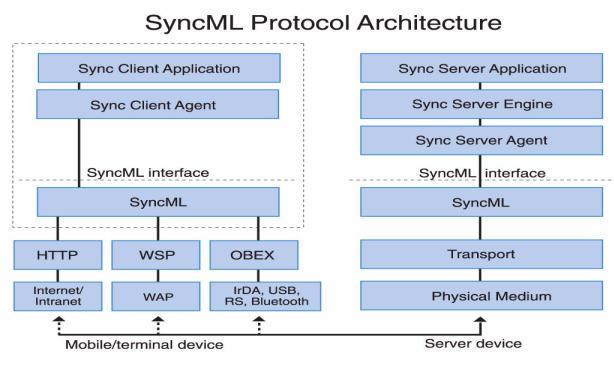
Benefits of a common synchronization protocol
End users
Today’s user of mobile devices probably uses a different synchronization product with every device. Each technology can synchronize only a few applications, or is limited to a particular type of network connection. This arrangement is expensive to install, confusing to configure and operate, and costly to administer. With SyncML, users will be able to buy devices that synchronize with a broader range of data.
Device manufacturers
Device manufacturers will benefit from a common protocol that will make the device interoperable with a broader range of applications, services, and network and transmission technologies.
Service providers
Service providers moving into the growth area of application hosting are particularly concerned that a proliferation of synchronization technologies will
White Paper T630/T628
make it impossible to deploy and support their customers in a cost-effective manner. To support the range of data types and devices in use today, service providers must install and configure multiple server infrastructures, maintain and support that infrastructure, and maintain compatibility and performance. The alternative now available, to use a single solution for data connectivity, involves the risk of a tight coupling to a propriety solution. With SyncML, they will be able to provide connectivity to a wider selection of applications.
Application developers
Choosing to support multiple synchronization technologies enables an application to support more types of devices and networked data, but that choice comes at a cost. With SyncML, application developers will be able to develop an application that can connect to a more diverse set of devices and network data.
26 |
October 2003 |
